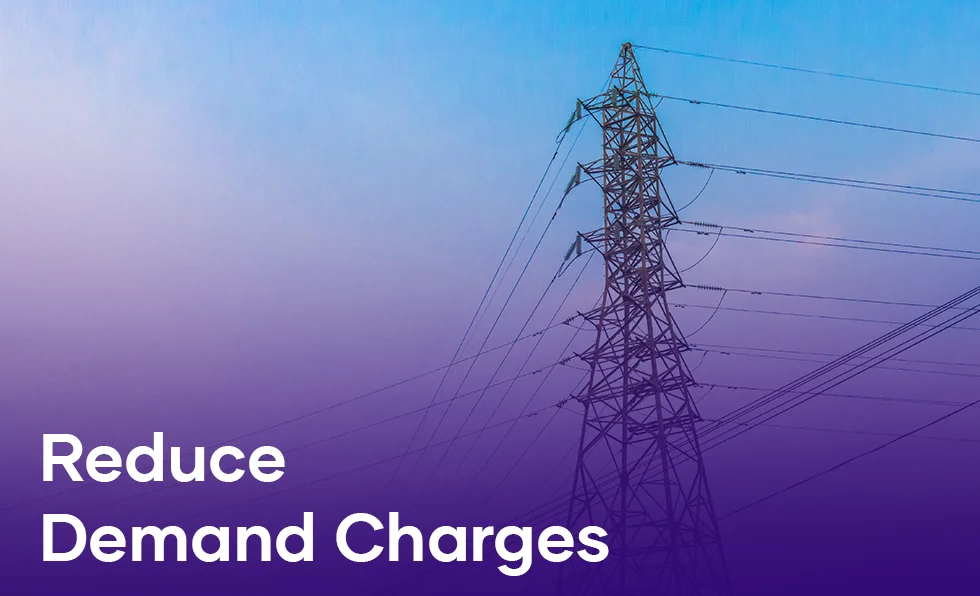
What Are Demand Charges?
Demand charges for electricity are the maximum amount of energy consumed during a billing period calculated in 15 or 30 minutes (demand intervals). The electrical demand charge shows the maximum power your business needs from the grid at a given time, unlike power charges based on total kilowatt-hours (kWh) consumed. Utilities must guarantee sufficient capacity to meet high usage, and supply charges contribute to the distribution of the costs associated with the infrastructure required to meet that capacity.
Example of How Demand Charges Work
Assume your company runs heavy machinery consuming 300 kW of power during peak hours. If your utility company charges $12 per kW for usage, then your demand charge for that month would be:
300 kW x $12 = $3,600
Even if your overall energy consumption is moderate, a high interest surge during peak hours can greatly raise your power bill. Therefore, understanding how to reduce consumption charges is crucial.
Key Factors Influencing Demand Charges
Time of Use (TOU):
Electricity usage increases on weekdays from 9 a.m. to 9 p.m., and utilities charge more.
Seasonal Rates:
Summer air conditioning use may increase consumption bills from some utilities.
Coincident Peak Demand:
If your maximum usage matches the utility’s system-wide peak interest, you’ll pay more.
Ratcheted Rates:
Some utilities determine usage costs on your highest peak over a defined historical period, often a year, so one high-usage month could affect rates for the following year.
Demand charge management strategies
Shift usage to off-peak hours
Shift high-demand activities to off-peak hours, reducing electricity consumption by moving activities to the weekends or evenings.
Example: To avoid peak pricing, you can run electrical appliances during off-peak hours. During on-peak hours (e.g., 9 a.m.–9 p.m. weekdays), power need across the grid is highest. Simultaneously, using irrigation systems during the night or early morning can help avoid high supply charges during the day.
Energy Storage Systems
Peak Shaving:
The use of battery energy storage systems (BESS) can lessen the load on the grid when electricity demand is high; it allows businesses to store energy during off-peak times and use it during on-peak periods; therefore, it will effectively reduce peak usage that results in greater costs. Ultimately, it will reduce the electrical demand charge, which supplies backup power in case of outages.
Load Shifting:
Utilize BESS to redistribute power utilization toward low-usage periods, thereby reducing demand charges. Therefore, load shifting involves spreading energy use more evenly throughout the day; thus, it will prevent sudden increases in consumption. Common approaches to accomplishing this goal include staggered start times for energy-intensive machinery and incorporating automation into energy management.
Energy Audits and Efficiency Improvements:
Conducting a power audit can help identify areas where consumption can be reduced. Electrical audits thoroughly analyze electricity usage patterns, equipment efficiency, and building insulation.
Upgrade Equipment:
Using power-efficient equipment results in low demand, meaning less strain on the grid during peak hours. This upgrading to more electricity-saving appliances includes HVAC systems, lighting, and industrial machinery. For example, replacing older lighting systems with modern, energy-efficient options can lower cooling requirements and enhance productivity.
On-Site Renewable Energy Generation:
Incorporating solar panels into your property can help balance your power use during peak hours. Combining solar with battery storage can save you the most money by providing energy when it’s most expensive to draw from the grid. On the other hand, solar power can also reduce your carbon footprint and demonstrate your commitment to sustainability.
Implement Thermal Storage:
Utilizing thermal storage systems is the wise option. Smart thermostats and power management systems can further optimize energy use, such as making ice at night for cooling during the day, reducing unnecessary consumption.
Communicate with Your Utility Provider:
Contact your local power provider to better understand how to reduce demand charges in electricity bills, get insight into the billing procedure, and formulate plans to reduce usage. They can also provide financial support for green power initiatives, another possibility.
The Role of Smart Technology in Managing Demand
Businesses are gaining more control over their power usage. It results from developments in innovative technologies such as smart grids and automated power management systems. In addition, they can monitor their energy consumption throughout the day; this is possible with the help of smart meters and other real-time energy monitoring tools.
Furthermore, it allows them to determine when and where significant supply spikes occur. Hence, by utilizing this information, businesses can make informed decisions regarding the timing of usage of electricity, automation of processes, and the allocation of energy-saving technologies.
Conclusion:
Demand costs are essential for energy cost control in businesses. By becoming familiar with what is electricity of demand, how demand charges work, and how to implement smart strategies, such as energy storage, load shifting, and on-site renewable generation. Furthermore, businesses can lower their electricity bills and help stabilize the grid.
If your business struggles with high consumption costs, consider consulting an energy expert to develop a customized strategy. You can achieve significant savings in the long run by implementing the correct solutions, such as installing a battery system, optimizing equipment, or upgrading your power management software.
More questions? Schedule a quick chat with our team!
